CHEVROLET MONTE CARLO 1996 5.G Owners Manual
Manufacturer: CHEVROLET, Model Year: 1996, Model line: MONTE CARLO, Model: CHEVROLET MONTE CARLO 1996 5.GPages: 340, PDF Size: 17.79 MB
Page 111 of 340

Downloaded from www.Manualslib.com manuals search engine NOTES
2-53
Page 112 of 340

Downloaded from www.Manualslib.com manuals search engine NOTES
2-54
Page 113 of 340
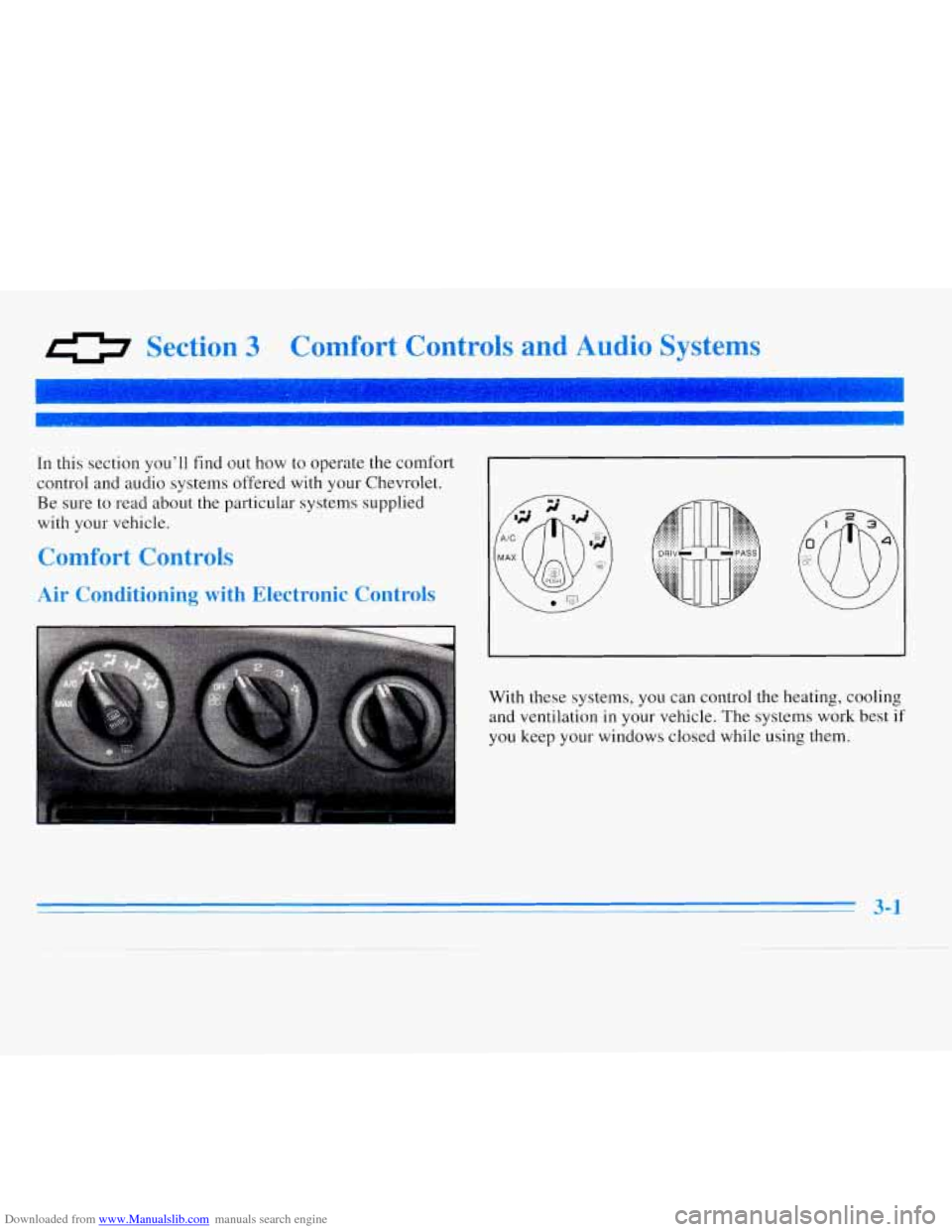
Downloaded from www.Manualslib.com manuals search engine 0 Section 3 Comfort Controls and Audio Systems
In this section you’ll find out how to operate the comfort
control and audio systems offered with your Chevrolet.
Be sure to read
about the particular systems supplied
with your vehicle.
Comfort Controls
Air Conditioning with Electronic Controls
With these systems, you can control the heating, cooling
and ventilation in your vehicle. The systems work best
if
you keep your windows closed while using them.
3-1
Page 114 of 340
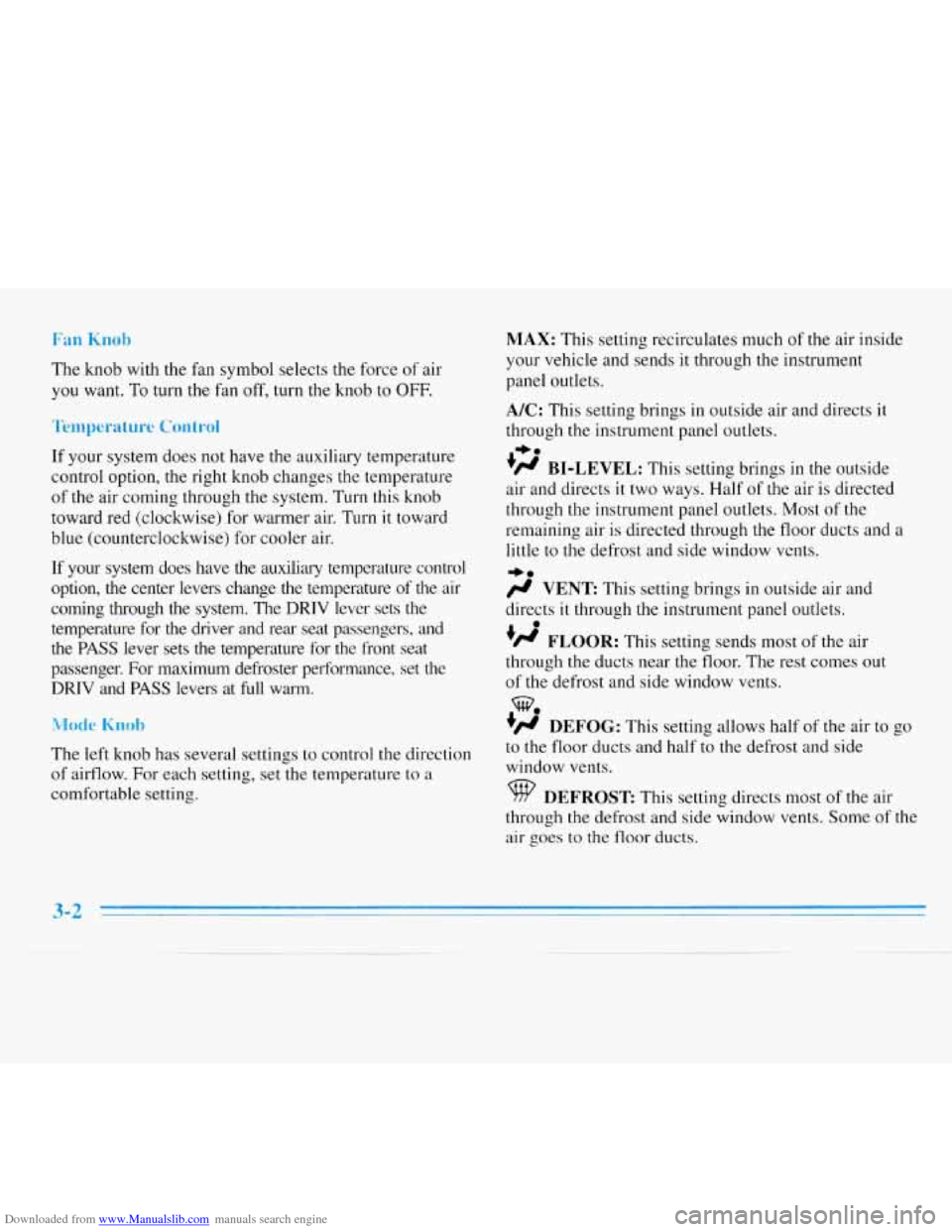
Downloaded from www.Manualslib.com manuals search engine Fan Knob
The knob with the fan symbol selects the force of air
you want. To turn the fan off, turn the knob to OFF.
Ten1perat.w-e Control
If your system does not have the auxiliary temperature
control option, the right knob changes the temperature
of the air coming through the system. Turn this knob
toward red (clockwise) for warmer air. Turn
it toward
blue (counterclockwise) for cooler air.
If your system does have the auxiliary temperature control
option, the center levers change the temperature of the air
coming through the system. The
DRIV lever sets the
temperature for the driver
and rear seat passengers, and
the
PASS lever sets the temperature for the front seat
passenger. For maximum defroster performance, set the
DRIV and PASS levers at full warm.
Mode Knob
The left knob has several settings to control the direction
of airflow. For each setting, set the temperature to
a
comfortable setting.
MAX: This setting recirculates much of the air inside
your vehicle and sends it through the instrument
panel outlets.
A/C: This setting brings in outside air and directs it
through the instrument panel outlets.
+fl BI-LEVEL: This setting brings in the outside
air and directs
it two ways. Half of the air is directed
through the instrument panel outlets. Most of the
remaining air
is directed through the floor ducts and a
little to
the defrost and side window vents.
+.
+e
/J VENT This setting brings in outside air and
directs
it through the instrument panel outlets.
'fl FLOOR: This setting sends most of the air
through the ducts near the floor. The rest comes out
of the defrost and side window vents.
+fl DEFOG: This setting allows half of the air to go
to the floor ducts and half to the defrost and side
window vents.
0
w.
9 DEFROST This setting directs most of the air
through
the defrost and side window vents. Some of the
air goes
to the floor ducts.
Page 115 of 340
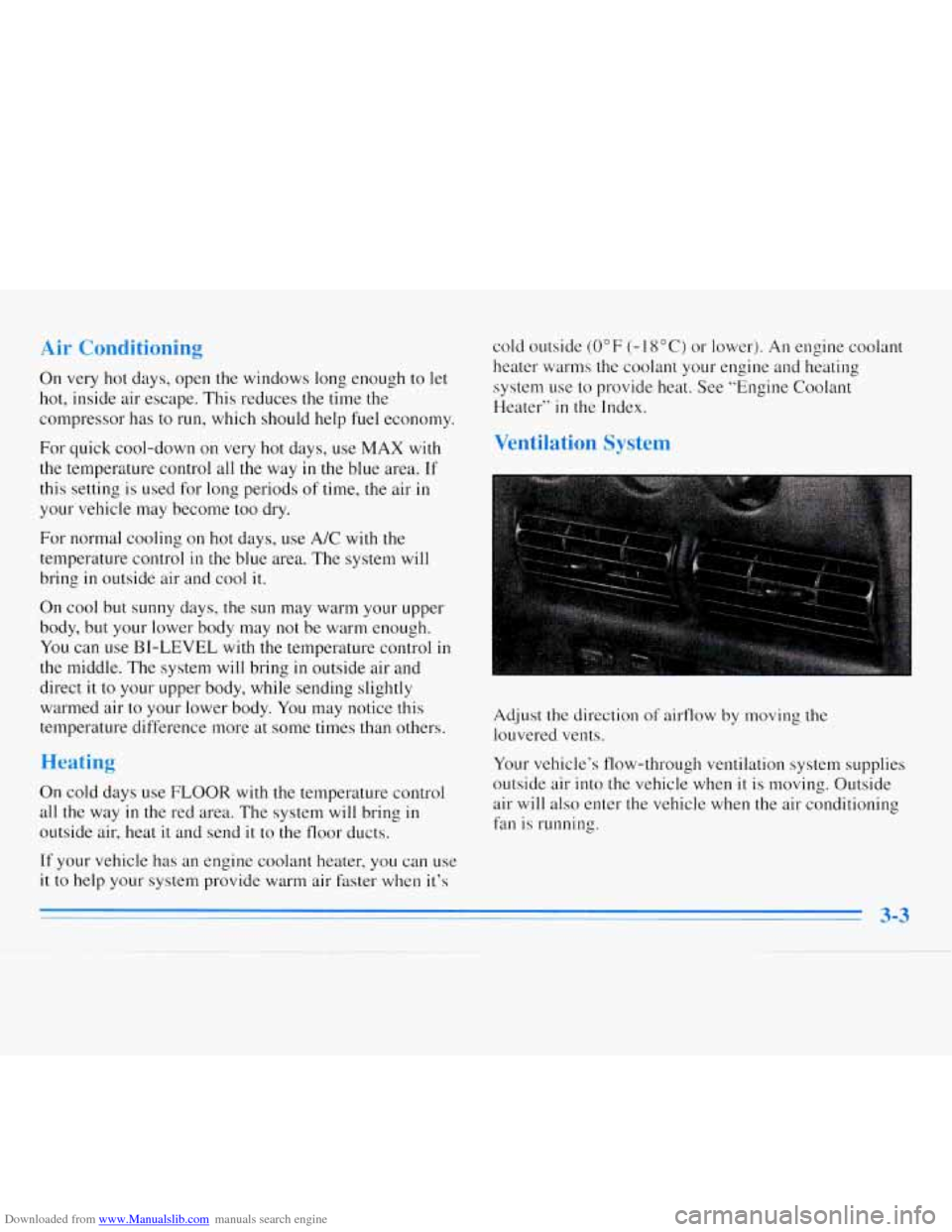
Downloaded from www.Manualslib.com manuals search engine Air Conditioning
On very hot days, open the windows long enough to let
hot, inside air escape. This reduces
the time the
compressor has to
run, which should help fuel economy.
For quick cool-down on very hot days, use
MAX with
the temperature control all
the way in the blue area. If
this setting is used for long periods of time, the air in
your vehicle may become too dry.
For normal cooling on hot days, use A/C with
the
temperature control in the blue area. The system will
bring in outside air and cool
it.
On cool but sunny days, the sun may warm your upper
body, but your lower body may
not be warm enough.
You can use BI-LEVEL with the temperature control in
the middle. The system will bring in outside air and
direct
it to your upper body, while sending slightly
warmed air to your lower body.
You may notice this
temperature difference more at some times than others.
Heating
On cold days use FLOOR with the temperature control
all the way in the red area. The system will bring in
outside air, heat it and send it to the floor ducts. cold
outside
(0°F (-18°C) or lower). An engine coolant
heater warms the coolant your engine and heating
system use to provide heat. See “Engine Coolant
Heater”
in the Index.
Ventilation System
Adjust the direction of airflow by moving the
louvered vents.
Your vehicle’s flow-through ventilation system supplies
outside air into the vehicle when
it is moving. Outside
air
will also enter the vehicle when the air conditioning
fan is running.
If your vehicle has an engine coolant heater, you can use
it to help your system provide warm air faster when it’s
3-3
Page 116 of 340
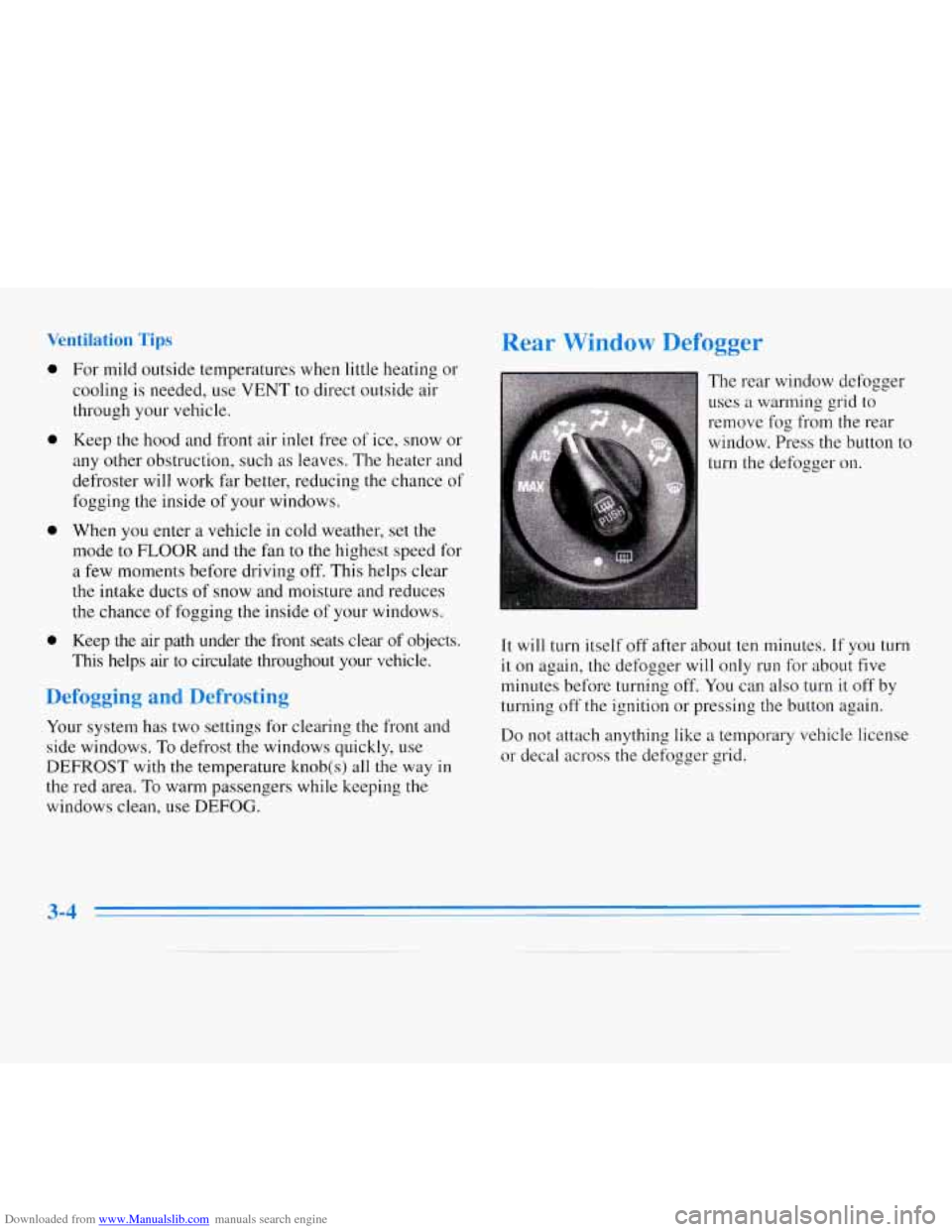
Downloaded from www.Manualslib.com manuals search engine 0
0
0
0
ilation Ti-
For mild outside temperatures when little heating or
cooling is needed, use
VENT to direct outside air
through your vehicle.
Keep the hood and front air inlet free of ice, snow or
any other obstruction, such
as leaves. The heater and
defroster will work far better, reducing the chance of
fogging the inside of your windows.
When you enter
a vehicle in cold weather, set the
mode to FLOOR and the fan to the highest speed for
a few moments before driving off. This helps clear
the intake ducts of snow and moisture and reduces
the chance of fogging the inside
of your windows.
Keep the air path under the front seats clear of objects.
This helps
air to circulate throughout your vehicle.
Defogging and Defrosting
Your system has two settings for clearing the front and
side windows.
To defrost the windows quickly, use
DEFROST with
the temperature knob(s) all the way in
the red area. To warm passengers while keeping the
windows clean, use DEFOG.
Rear Window Defogger
The rear window defogger
uses a warming grid to
remove fog
from the rear
window. Press the button to
turn the defogger on.
I
It will turn itself off after about ten minutes. If you turn
it on again, the defogger will only run for about five
minutes before turning off. You can also turn
it off by
turning
off the ignition or pressing the button again.
Do not attach anything like a temporary vehicle license
or decal across the defogger grid.
3-4
Page 117 of 340
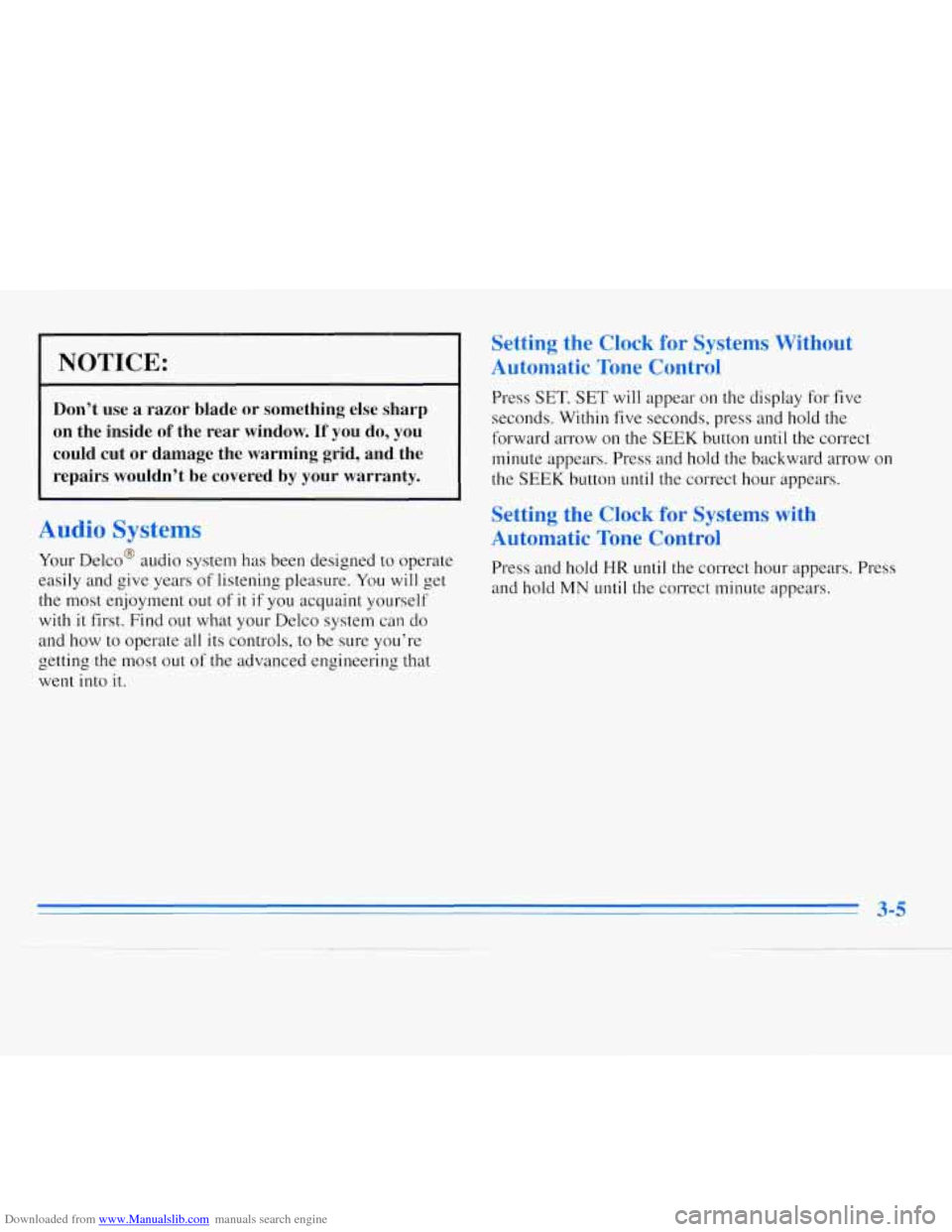
Downloaded from www.Manualslib.com manuals search engine I NOTICE:
Don’t use a razor blade or something else sharp
on the inside
of the rear window. If you do, you
could cut or damage the warming grid, and the
repairs wouldn’t be covered by your warranty.
Audio Systems
Your DelcoB audio system has been designed to operate
easily and give years of listening pleasure. You will get
the most enjoyment out of it if you acquaint yourself
with it first. Find out what your Delco system can do
and how to operate all its controls, to be sure you’re
getting the most out
of the advanced engineering that
went into
it.
Setting the Clock for Systems Without
Automatic Tone Control
Press SET. SET will appear on the display for five
seconds. Within five seconds, press and hold the
forward arrow on the
SEEK button until the correct
minute appears. Press and hold the backward arrow on
the
SEEK button until the correct hour appears.
Setting the Clock for Systems with
Automatic
Tone Control
Press and hold HR until the correct hour appears. Press
and hold
MN until the correct minute appears.
3-5
Page 118 of 340
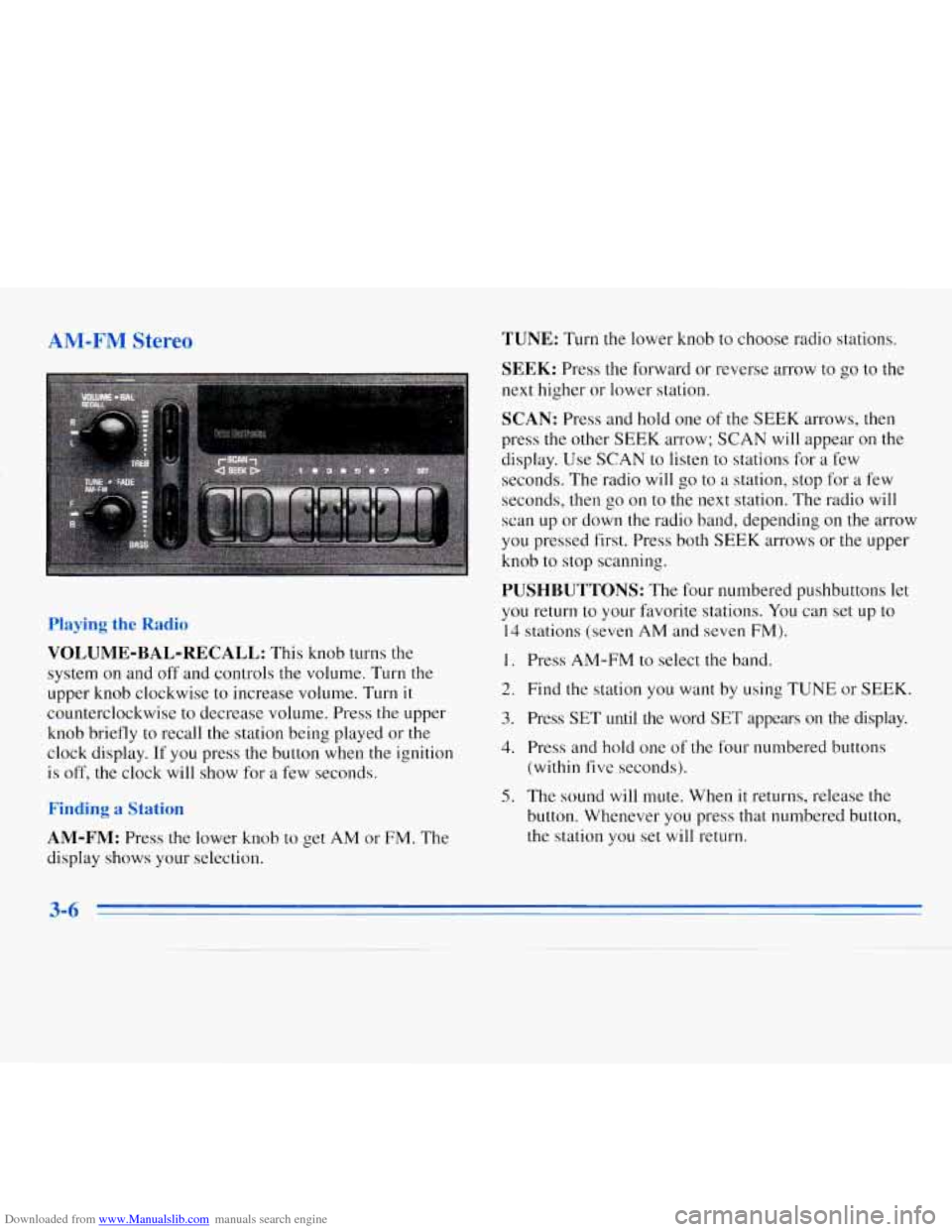
Downloaded from www.Manualslib.com manuals search engine M-FM Stereo
VOLUME-BAL-RECALL: This knob turns the
system
on and off and controls the volume. Turn the
upper knob clockwise to increase volume. Turn
it
counterclockwise to decrease volume. Press the upper
knob briefly to recall the station being played or the
clock display. If you press the button when the ignition
is off, the clock will show for a few seconds.
nding St;
AM-FM: Press the lower knob to get AM or FM. The
display shows your selection.
TUNE: Turn the lower knob to choose radio stations.
SEEK: Press the forward or reverse arrow to go to the
next higher or lower station.
SCAN: Press and hold one of the SEEK arrows, then
press the other SEEK arrow; SCAN
will appear on the
display. Use SCAN to listen to stations for a few
seconds. The radio will go to a station, stop for
a few
seconds, then go on to the next station. The radio will
scan up or down the radio band, depending on the arrow
you pressed first. Press both SEEK arrows or the upper
knob
to stop scanning.
PUSHBUTTONS: The four numbered pushbuttons let
you return to your favorite stations. You can set
up to
14 stations (seven AM and seven FM).
1.
2.
3.
4.
5.
Press AM-FM to select the band.
Find the station you want by using TUNE or
SEEK.
Press SET until the word SET appears on the display.
Press and hold one of the four numbered buttons
(within five seconds).
The sound will mute. When
it returns, release the
button. W-henever you press that numbered button,
the station you set will return.
Page 119 of 340
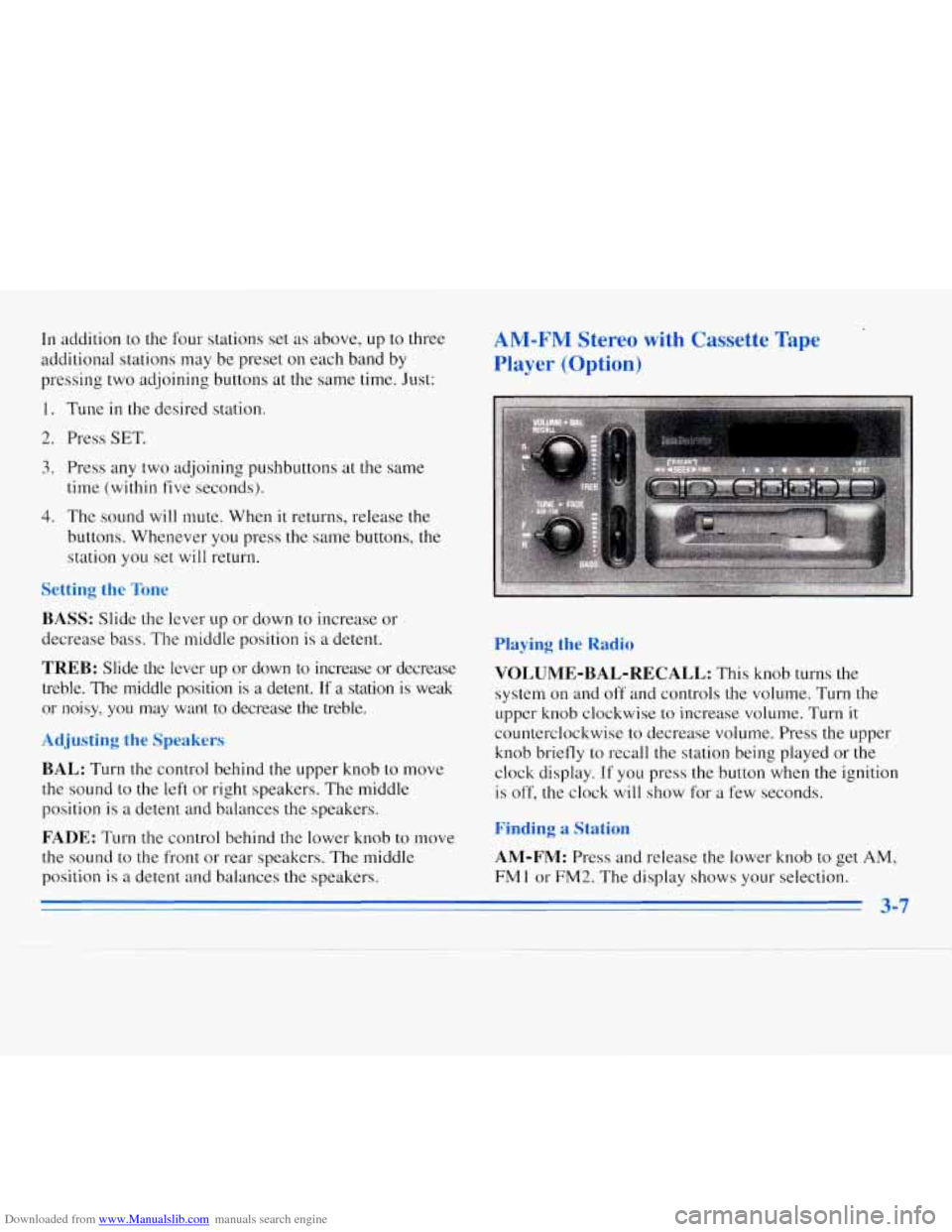
Downloaded from www.Manualslib.com manuals search engine In addition to the four stations set as above, up to three
additional stations may be preset on each band by
pressing two adjoining buttons at the same time. Just:
1. Tune in the desired station.
2. Press SET.
3. Press any two adjoining pushbuttons at the same
time (within five seconds).
4. The sound will mute. When it returns, release the
buttons. Whenever you press the same buttons, the
station
you set will return.
Setting the Tone
BASS:
Slide the lever up or down to increase or
decrease bass. The middle position is a detent.
TREB: Slide the lever up or down to increase or decrease
treble. The middle position is
a detent. If a station is weak
or noisy, you may want to decrease the treble.
Adjusting the S.peakers
BAL:
Turn the control behind the upper knob to move
the sound
to the left or right speakers. The middle
position is
a detent and balances the speakers.
FADE: Turn the control behind the lower knob to move
the sound to the front or rear speakers. The middle
position
is a detent and balances the speakers.
AM-FM Stereo with Cassette Tape
Player (Option)
Playing the Radio
VOLUME-BAL-RECALL:
This knob turns the
system on and off and controls the volume. Turn the
upper knob clockwise to increase volume. Turn it
counterclockwise to decrease volume. Press the upper
knob briefly to recall the station being played or the
clock display.
If you press the button when the ignition
is off, the clock
will show for a few seconds.
Finding a Station
AM-FM:
Press and release the lower knob to get AM,
FM 1 or FM2. The display shows your selection.
3-7
Page 120 of 340
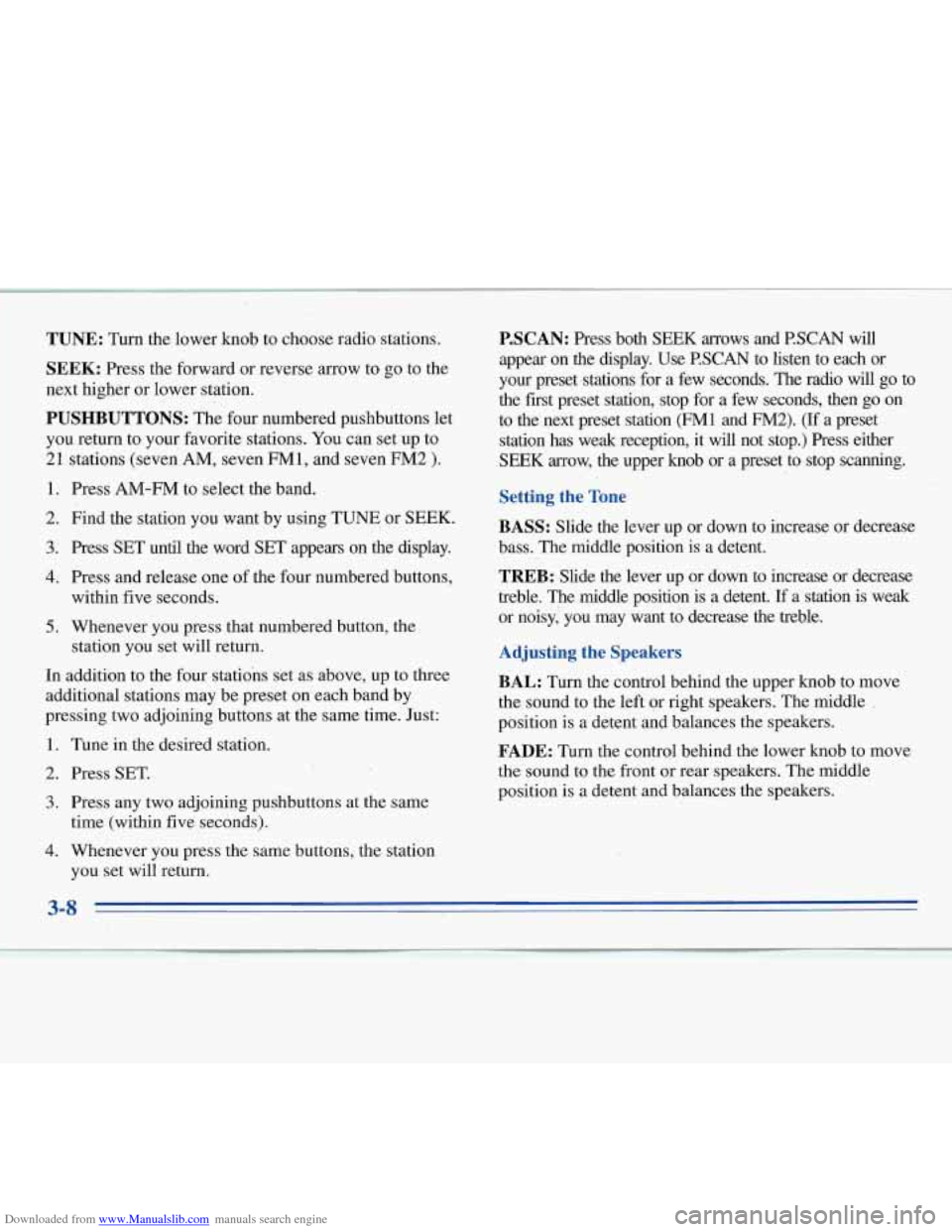
Downloaded from www.Manualslib.com manuals search engine TUNE: Turn the lower knob to choose radio stations.
SEEK: Press the forward or reverse arrow to go to the
next higher or lower station.
PUSHBUTTONS: The four numbered pushbuttons let
P.SCAN: Press both SEEK arrows and PSCAN will
appear on
the display. Use PSCAN to listen to each or
your preset stations for a few seconds.
The radio will go to
the first preset station, stop for a few seconds, then go on
to the next preset station (FMl and
FM2). (If a preset
you return to your favorite stations. You can set up to
21 stations (seven
AM, seven FM 1, and seven FM2 ).
1. Press AM-FM to select the band.
2. Find the station you want by using TUNE or SEER.
3. Press SET until the word SET appears on the display.
4. Press and release one of the four numbered buttons,
within five seconds.
5. Whenever you press that numbered button, the
In addition to the four stations set as above, up to three
additional stations may be preset on each band by
pressing two adjoining buttons at the same time. Just:
1. Tune in the desired station.
2. Press SET.
3. Press any two adjoining pushbuttons at the same
4. Whenever you press the same buttons, the station
station
you set will return.
time (.within five seconds).
you set will return.
3-8
station has weak reception, it will not stop.) Press either
SEEK arrow, the upper knob or a preset to stop scanning.
Setting the Tone
BASS:
Slide the lever up or down to increase or decrease
bass. The middle position is
a detent.
TREB: Slide the lever up or down to increase or decrease
treble. The middle position is a detent.
If a station is weak
or noisy, you may want to decrease the treble.
Adjusting the Speakers
BAL: Turn the control behind the upper knob to move
the sound to the left or right speakers. The middle
.
position is a detent and balances the speakers.
FADE: Turn the control behind the lower knob to move
the sound to the front or rear speakers. The middle
position is a detent and balances the speakers.